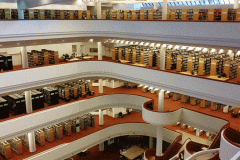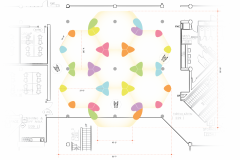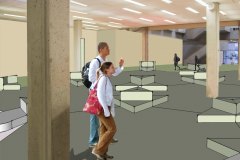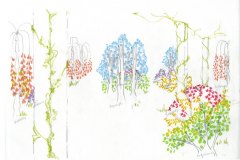This project was my 2016 undergraduate thesis from the York University / Sheridan College Joint Program in Design. This project was also published in the Communication + Place Journal by the Society of Experiential Design in 2017.

How can the search experience within a school library promote curiosity and encourage multidisciplinary exploration?
PROBLEM
Online library catalogues promise to do the difficult labour for the user, but the promise of speed and efficiency from online results take away the learning process and unplanned moments of discovery. These are critical pivoting steps that students should have when starting a research project. Students also want to find resources that they can understand, which prevents them from searching for sources outside of their scope of familiarity. Entering key search words are not always intuitive when trying to find reliable and useful books and articles.
SOLUTION
The solution to this problem is to give students the opportunity to search and visualize search results related to their topic from various faculties within their school. By finding resources from different disciplines, students can gain holistic and critical perspectives on their topic.
EXECUTION
I designed a proposal for an interactive garden installation within York University’s Scott Library that provides a way for students to begin research-based assignments as a journey that explores multiple disciplines.

The Resource Garden is an experiential design proposal that includes a floor plan, elevation chart, user journey, mobile application, and artefact prototypes.
Demo / User Journey
Design
Floor Plan
The Resource Garden is situated in the Learning Commons of York University’s Scott Library. It has 7 garden pods in the shape of hexagons. Each garden pod is surrounded by 6 different Faculty Plant Families to allow students to experience the searching process within a physical space. Faculty Plant Families reveal sources from a variety of disciplines that students can explore by walking inside the pod. Wheelchair users were considered in the design of the installation so that they have access to all spaces and services.

Elevation Chart
Each Faculty Plant Family has its own set of unique Book Buds that emit coloured lights once a relevant book is found. Users can pick them off and scan them with the Resource Garden Mobile App. The features in the App allow users to find books easily in the library, download online PDFs, put books on hold, and archive it for future references.

Book Buds
The Book Buds are acrylic pieces that emit light when a search result is found in its corresponding faculty. Upon activation through the Resource Garden App, it will store information about the book that the user wants to find in the library. Fibre optic cables connect the Book Buds to the search engine system. Book Buds contain Near Field Communication (NFC) chips that can store information once it is transferred from the search engine system through the fibre optic cables. Users can then pick them off like picking a leaf off of a plant and scan the NFC chips to find the book’s location in the library. Users can make several actions upon scanning the Book Bud, which are mentioned in the next section.
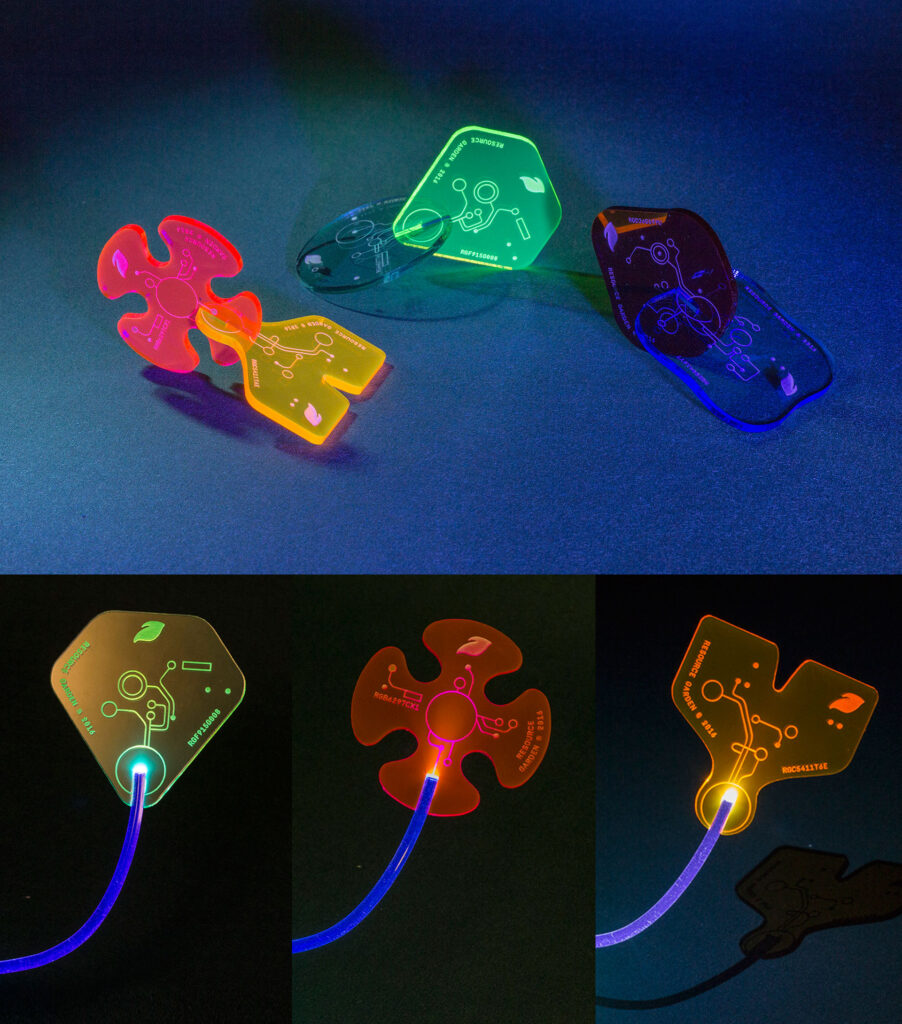
Mobile App
The Resource Garden App allows users to interact with the Book Buds in the Garden Pod. It is where users enter key words of their research topic to get the visualization of results in the garden. When the device is in close proximity to a Faculty Plant Family, it scans the search results from the faculty and displays them to the user. After selecting a search result in the app, Book Buds will respond by emitting coloured lights and storing information that can be scanned.
Scanning Book Buds with the app allows the user to locate the book in the library, download a PDF if the result is an online resource, or add it to a wish list if it has been checked out. Since this garden system requires a mobile device to host this app, the library must allow users to rent devices with the app installed if they do not have their own smart-devices.


Proposal Document
The design, research, and process documentation pieces are contained in this proposal book.

Research
ethnographic Research
To gather primary research data, I performed an ethnographic research through photo-observational analysis. I visited 7 academic and public libraries in Toronto and the G.T.A. (Greater Toronto Area) to get an overview of how people use the library for various purposes. I specifically focused on the user’s journey of the learning commons area because a great portion of the library’s service is provided there. I took notes on how people interacted with the employees, other guests, technological devices, and the architectural space.
I took the notes and summarized them into a chart using the A.E.I.O.U. method² which analyzes the critical points of Activities, Environment, Interaction, Object, and Users. The chart below displays a summary of points I organized using this method:

Online Survey
After this analysis, I conducted an online survey, which targeted the undergraduate university students of York University to gather information on their thoughts towards librarians and how they use the library’s services.
From the survey results, I discovered that many students that used York University’s Scott Library did not engage with the librarians due to the inconvenience of finding their availability and their desire to work independently. I grouped their comments into categories to see how often similar points were brought up during the survey.
Below is an example of how I surveyed the comments from one question (click to enlarge):
This research process helped me develop a clear demographic, psychographic, and functional approach to a design solution that would help solve the immediate and indirect issues that students often faced when using their university libraries. I expanded upon this research by creating personas, competitive analysis, and a step-by-step scenario of how the library service system can be redesigned to create a more engaging and useful experience for students.
Research Report
You can find the full details of the project proposal I prepared before I began the design process of the Resource Garden here:
Process
Floor Plan Design
I went through several renditions of the floor plan so that all garden pods can be connected with each other to create the appearance of a luscious garden. At the same time, I wanted it to be accessible for users that need wheelchair, vision, and hearing assistance to not discriminate any students.
Elevation Chart Design
These are my first concepts of organic garden formations that users can interact with the gather resources.
Book Buds Manufacturing
Designing the Book Buds required a lot of experimentation with different forms and materials. There was a great learning outcome in the process of prototyping and researching about materials.
Garden Modeling
Using Sketch Up, the dimensions of the garden were drawn into the Learning Commons space of York University’s Scott Library.
References
Citations
¹Bell, G., Blythe, M., & Sengers, P. (2005). Making by making strange. ACM Transactions on Computer-Human Interaction ACM Trans. Comput.-Hum. Interact. TOCHI, 12(2), 149-173.
²Martin, B., & Hanington, B. M. (2012). Universal methods of design: 100 ways to research complex problems, develop innovative ideas, and design effective solutions. Beverly, MA: Rockport.
Readings
Battles, M. (2004). Library: An Unquiet History. New York City, New York: WW Norton.
Grady, J., & Grady, K. (2006). A designer’s research manual: Succeed in design by knowing your clients and what they really need. Gloucester, Mass.: Rockport.
Mack, D., & Gibson, C. (2012). Interdisciplinarity and Academic Libraries: ACRL Publications in Librarianship No. 66. Chicago, Illinois: Association of College and Research Libraries, a division of the American Library Association.
Martin, B., & Hanington, B. (2012). Universal methods of design 100 ways to research complex problems, develop innovative ideas, and design effective solutions (Digital ed.). Beverly, MA: Rockport.
Rugg, J. (2010). Exploring site-specific art issues of space and internationalism. London: I.B. Tauris.
Sheil, B. (2008). Protoarchitecture: Analogue and digital hybrids. London: John Wiley.
Stickdorn, M., & Schneider, J. (2012). THIS IS SERVICE DESIGN THINKING: Basics, Tools, Cases. London: Wiley.
Weitz, S. (2014). Search: How the data explosion makes us smarter. Brookline, MA: Bibliomotion.






